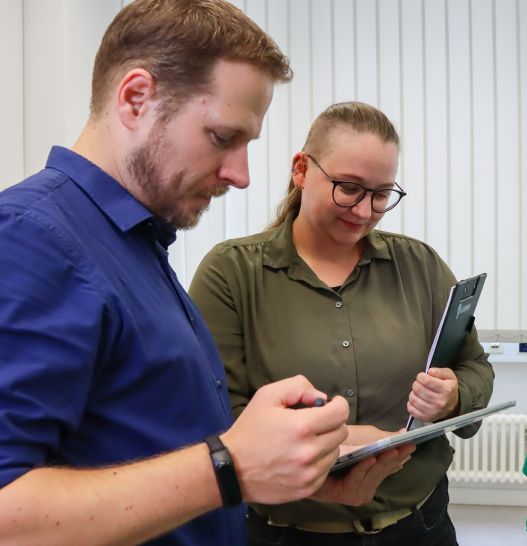We dug deep into the topic of Usability Engineering File and came back for you with all the important info. In this article, you will learn the answers to the following questions:
- What is a Usability Engineering File?
- What belongs in a UEF?
- What are best practices for creating a Usability Engineering File?
- How do Notified Bodies review Usability Engineering Files?
- How does a Usability Engineering File pay into the work of risk management?
- What are the biggest challenges in creating a Usability Engineering File?
Enjoy reading!
A brief introduction: Why is usability engineering so important for medical device development?
A Usability Engineering File (UEF), also called a usability file in IEC 62366-1, is an important part of the technical documentation of medical devices and thus essential for MDR approval in Europe. It contains all information and results collected during the usability engineering process, including the analysis of user requirements, the definition of user profiles and scenarios, the performance of formative and summative evaluations, and the assessment of user feedback. The UEF serves as evidence of compliance with usability requirements and can be used as evidence of product safety and effectiveness in the event of regulatory audits or product liability lawsuits.
IEC 62366-1 provides the somewhat shorter definition: “Collection of records and other documents created during the usability engineering process.” (Source: IEC 62366-1; 3.18)
What belongs in a Usability Engineering File?
In summary, a complete documentation of your usability engineering activities belongs in the UEF. In detail, these are the points that need to be documented:
- Use Specification (IEC 62366-1:2021-08; chapter 5.1): These include the Intended Medical Purpose, the Intended User Profile, the Intended Patient Population, the Intended Use Environment, the Intended Body Part or Tissue Type on which the device is to be used (Type of Tissue/Part of Body), and the Operating Principle of the medical device.
- All user interface characteristics related to safety and potential use errors (IEC 62366-1:2021-08; chapter 5.2): You record which user interface characteristics can be risky for the user, for patients and third parties. From this, you then derive operating errors that can occur during use.
- Known or foreseeable Hazards and Hazardous Situations (IEC 62366-1:2021-08, chapter 5.3): Here you record what you found out during the “Determination of known or foreseeable hazards and hazardous situations”.
- All hazard-related use scenarios (IEC 62366-1:2021-08, chapter 5.4): You must then derive and document hazard-related use scenarios (Hazard-Related-Use Scenarios) from all identified hazards and hazard situations. These contain: all tasks of the scenario, the sequence of the tasks and the severity of the associated harm.
- If you want to perform a summative usability evaluation: For this you need not only the description of the test plan for the usability tests, e.g., test objectives, test tasks, test protocols, and the test results (description of the results from the usability tests, e.g., quantitative (e.g., success rate) and qualitative (e.g., user feedback)), but also a justification why you have made this selection of test scenarios for the summative evaluation. (cf. IEC 62366-1:2021-08, chapter 5.5)
- User Interface Specification: Here, the IEC requires you to document three things: 1. All testable technical requirements relevant to the user interface. 2. all accompanying documents that exist for your medical device (e.g. manuals, instructions, etc.). 3. you must document whether user training is required for your medical device. (source: IEC 62366-1:2021-08, chapter 5.6)
- User Interface Evaluation Plan (IEC 62366-1:2021-08, chapter 5.5): The User Interface Evaluation Plan is a document that specifies how you will check whether the interface of your medical device carries risks.
- Design Changes: Description of changes made to the design of the product based on the test results.
- Evaluation: Evaluation of the product in terms of usability and recommendations for usability improvement.
- Further documentation: All results of possible tests or studies including all relevant documents, e.g. test protocols, design changes, etc.
What are the best practices for creating a Usability Engineering File?
Be meticulous about documenting the complete usability engineering process. We have already mentioned it in another article: What is not documented did not happen. At least for the Notified Bodies. This is also very important for internal work (see next point).
Make sure that all documented contents are traceable! For Notified Bodies, but also for your colleagues, it is extremely important that all documented contents can be traced at any time. This can save valuable time when documenting subsequent products, but can also be necessary if you ever have to prove in a legal case that you have taken all the necessary measures to ensure operating safety.
If you are conducting a study: Already at the creation and planning stage, make sure that the user groups are not only properly defined and documented, but also fit for your study. Strictly speaking, this point does not belong to the topic “Usability Engineering File”, but it plays an important role. The tip at this point: Make sure that your user groups are correctly represented already when creating the UEF!
Pay special attention to evidence of how potential use errors are identified and mitigated or eliminated! This point is particularly important for the successful approval of your medical device, as this is where much of the proof of the safe use of your product occurs.
Always review your documentation when you change something. Only those who keep their documentation up to date and check it for completeness and accuracy are on the safe side.
Try to keep the UEF as lean as possible: This means not only that the Usability Engineering File itself should be as lean as possible, but also that you should place the required information in other documents (if possible) and then only refer to them in the UEF. This way you avoid duplications and make it easier to keep the documentation up to date afterwards.
How are Usability Engineering Files reviewed by Notified Bodies?
A Notified Body examines the Usability Engineering File as part of the conformity assessment of a medical device. This is done in accordance with the requirements of the MDR. Attention is paid to the following points:
Completeness: Does the UEF contain all the information and documents mentioned in the previous chapter that are necessary for assessing the usability of the medical device?
Methods and Results: Are the methods described in the Usability Engineering File suitable for evaluating usability? Were the results of the evaluations sufficiently documented and correctly interpreted?
Fulfillment of requirements: Does the UEF demonstrate that the relevant usability requirements for the medical device have been met? You can already guess: This point is particularly important for the approval of your medical device!
Consistency and freedom from contradictions: Is the UEF consistent? Does it not contain contradictions?
The question of whether a usability engineering process exists is examined: So, it is not only about the content documentation of the process, but also about the documentation of the process as a procedure instruction. In addition, it is checked whether you have adhered to your process.
How does a UEF contribute to the work of risk management?
The Usability Engineering File shows how you identified (and then later mitigated) potential application errors and associated risks. It therefore provides a very important input for the risk management process.
The usability engineering process and the risk management process are closely related. The two processes run in parallel and are integrated with each other.
What does the UEF provide to risk management? Information about how users use the product, what problems or difficulties can occur, and how they can be resolved. Risk management can then use this information to identify and assess potential risks.
What does Risk Management provide for the Usability Engineering Process and in particular for the Usability Engineering File? When necessary, it provides feedback and requirements to the UEF to ensure that the usability of the product is adequately addressed in terms of risks.
What are the biggest challenges in creating a Usability Engineering File?
Several challenges can arise when creating a Usability Engineering File. We have identified the following for you:
- The high complexity of the usability engineering process: Usability engineering involves many steps (including analyzing user requirements, defining use cases, and conducting usability tests) that must be well planned and executed with expertise. Having the clear eye for proper documentation here requires practice and an overview of the process and MDR requirements.
- Companies or product managers often take too long to create the use specification, which means that the user group and the usage environment are not clearly defined in the ongoing process. As a result, development does not proceed as purposefully as it otherwise would.
- Resources can quickly exceed in-house capabilities: Usability engineering requires specialized skills, resources, and equipment that may not be available internally. It can be difficult to provide the necessary resources.
- Especially the resources Time and Costs: The creation of the Usability Engineering File and the Usability Engineering steps require a lot of time and resources, which can lead to higher costs. Especially if you have a tight schedule.
- Standards and regulations must be observed and are often complex to understand: The UEF must comply with the requirements of the relevant standards and regulations (which requires a thorough understanding of these requirements). The interpretation of the requirements often makes the implementation of the requirements in practice very difficult.
- Necessary and well-coordinated collaboration: Usability engineering often requires collaboration between different departments. This can be a challenge. Especially when it comes to integrating feedback and prioritizing requirements.
- Planning and Commitment: Overall, the creation of a Usability Engineering File requires a great deal of planning, collaboration, and commitment to ensure that the product meets the needs and requirements of users and complies with standards and regulations.
Conclusion
A Usability Engineering File is the most pragmatic way to prove all requirements of the MDR regarding usability. Accordingly, you should pay special attention to its creation and provide all contents and document them in a traceable manner.
Whether it is worthwhile to have the Usability Engineering File created internally or externally depends on your specific case.
Do you need help with your Usability Engineering File or usability documentation in general? Please feel free to contact us via our contact form. We are looking forward to hearing from you.



